Blog
The Walls of Athens as an Archive of Anti-Austerity Movements
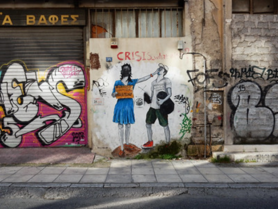
“Crisis, What Else”. Photo by Julia Tulke in online collection aestheticsofcrisis. Athens, Metaxourgeio, Greece. Taken in 2020.
Stella Koudouma (ReAct intern)
Any walk through the center of Athens involves a visual encounter with street art and graffiti. Murals, like the one above, can be found all over the city center and are emblematic of the austerity period. Crisis as ever-present in contemporary Greece is captured by the slogan “Crisis…what else?”, which plays with the advertising slogan “Nespresso…What else?”. This phrase evokes the inevitability of crisis in late-stage capitalism. Since the 2008 protests, ignited by the murder of Alexis Grigoropoulos, who was killed by a police officer, and the 2011 anti-austerity protests soon after, street art and graffiti have appeared all over Athens, acting as a form of political intervention. Activists have left traces of the years of crisis and austerity on the city walls.
As interest in graffiti from the crisis grows, images of these remnants have increasingly found their way into online photography collections. One striking photography collection of street art and graffiti is Julia Tulke’s “aesthetics of crisis” on Flickr. Tulke has created a website, with the same name, that includes interviews with artists and photographs from her exhibition on Athenian street art of crisis. Some photographs provide the date of the graffiti but for others the date is unspecified, as it is unknown when the particular artwork was created. Thus, the graffiti can be differentiated on the basis of its production: some works from the time of the protests have remained on the walls, whereas others recycle old graffiti slogans or transform them in creative ways. Looking at these online collections, I wondered how subsequent street art remembers the anti-austerity movements of 2010 and 2011. Could the recycling and creation of new graffiti be an attempt to keep the movement alive? What kind of memory work is graffiti? As it recycles and preserves anti-austerity’s repertoire of contention could graffiti be described as a dynamic archive of the Syntagma Square movement?
The Greek anti-austerity movement can be split into a first wave of general strikes and protests in 2010, followed by a second stage, from May 2011 until the end of July 2011, during which the Syntagma Square, and other squares across the country, were occupied in protest against the memorandum of financial assistance to the Greek government to pay off the debt and imposed the austerity measures. These protests have been called the “Indignant movement” or the “Syntagma Square movement”. The third stage, from the end of 2011 until 2014, is a period of civil disobedience against the effects of austerity. This period is described as the Greek “Crisis”. While scholarly work has emphasized Greek graffiti as an aesthetic and political expression of generalized “Crisis”, my interest lies in graffiti that commemorates the Syntagma Square movement.
I refer here, in a broad sense, to street art and graffiti as public, urban art that is ephemeral; often but not exclusively illegal; and drawn or written on walls and objects. Often street art has political and activist undertones, as it intervenes in public spaces with revolutionary content and intent. Many studies argue that during the anti-austerity movements the painted walls became an “arena” in which contentious ideologies were brought into discussion with each other. Although during the anti-austerity movement street art acquired the status of activism, it is not yet clear if writing on walls has become a commemorative medium for the Syntagma Square movement.
One way in which graffiti preserves the memory of the Syntagma Square movement is via the continued practice of drawing and painting public spaces as a form of protest. Graffiti created since the anti-austerity movement still conveys political messages against those who impose austerity measures. Take, for example, the following graffiti slogans against IMD (ΔΝΤ). They were created in 2015, by activists in later movements that cannot be categorized as anti-austerity. As activists use wall writing as a form of activism, the repertoire of contention of the Syntagma Square movement is repeated. Although this is not a new protest practice, it has become more prominent – giving a sense that the streets belong to the city’s residents and enacting an “immediate democracy” (which was one of the main calls of the anti-austerity movement).
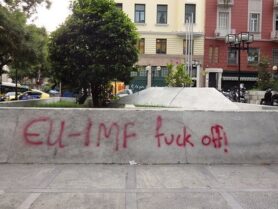
“EU-IMF fuck off”. Photo by Julia Tulke in online collection aestheticsofcrisis. Athens, Exarcheia, Greece. Taken in 2015.
The content of anti-austerity graffiti is re-mediated from past to present and from wall to wall. When activists reuse anti-austerity graffiti slogans, recycling the slogans and using them for later movements, they commemorate the movement they were originally part of. Slogans such as “κλέφτες/ thieves”, which accuses Greek and European politicians of stealing people’s money and futures and the work “OXI/ NO”, which was chanted during the protests as a symbol of collective defiance, are both recycled on walls and reused by later movements.
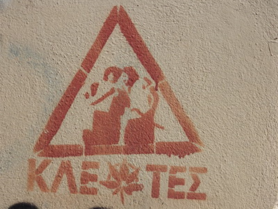
“Kleftes”. Photo by Julia Tulke in online collection aestheticsofcrisis. Athens, Exarcheia, Greece. Taken in 2013.
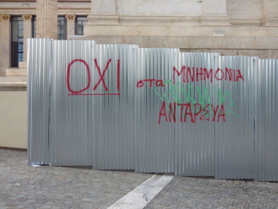
“No to Memoranda”. Photo by Julia Tulke in online collection aestheticsofcrisis. Athens, Akadimia, Greece. Taken in 2015.
Calls such as “Wake Up” (Ξυπνήστε) or “Rise Up” (Ξεσηκωθείτε), which were used during the anti-austerity movement, have been reiterated on the city walls years after, transferring their incitement for ideological and political change to the present. Their reception is based on observer’s meaning-making abilities, their memories and their dialogical relationship with the urban environment. Bystanders recall the effects of the anti-austerity movement on their everyday lives, making the city walls into a dynamic site of memory.
“Wake Up”. Photo by Julia Tulke in online collection aestheticsofcrisis. Athens, Omonoia, Greece. Taken in 2013.More complex artworks further reflect anti-austerity claims that relate to economic and political reform. Protesters’ main claim was that, because of corruption and hegemonic power structures, the current liberal capitalist system and representative democracy were not working. This position of “us” versus “them” (that is, the people and citizens versus the political and economic elites) appers all over the city walls. New artwork echoes resistance to Greek and European corruption and implicitly transfers the memory of anti-austerity protests to the present.
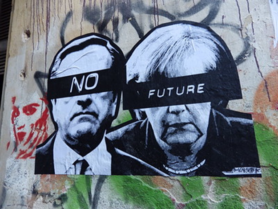
“No Future”. Photo by Julia Tulke in online collection aestheticsofcrisis. Athens, Exarcheia, Greece. Taken in 2013.
Recycling graffiti slogans and complex artworks, referring to indignation against the political system, keeps the memory of the anti-austerity movement alive. While not all street art is created with the intent of commemorating the Syntagma Square movement, the continued presence of graffiti on the Athenian walls explicitly or implicitly alludes to the anti-austerity protests. The city has become a palimpsest of collective memory in which graffiti is constantly re-mediated, prolonging the memory of the Syntagma Square movement. Street art is not only a form of activism but can also commemorate past social movements.
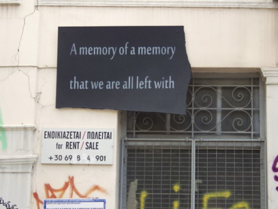
“A memory of a memory that we are all left with”. Photo by Julia Tulke in online collection aestheticsofcrisis. Athens, Kerameikos, Greece. Taken in 2015.


